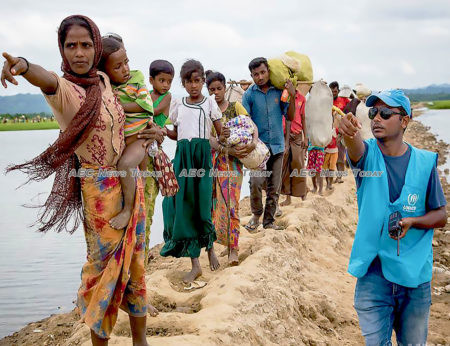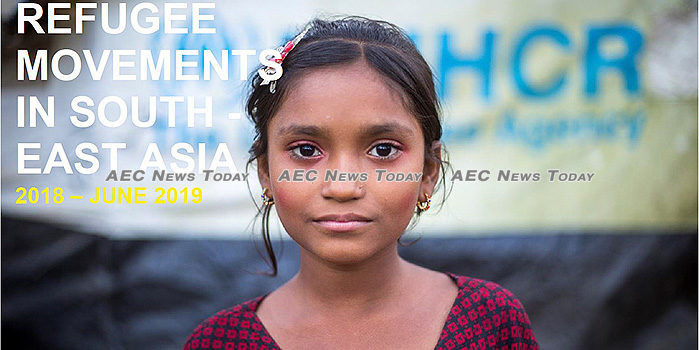A United Nations High Commissioner for Refugees (UNHCR) report released in Bangkok yesterday (Oct 1) highlights the critical threats and risks refugees and asylum seekers in Southeast Asia face while seeking safety and a better future for themselves and their families.
Four years after the 2015 Andaman sea crisis the report, Refugee Movement in South-East Asia 2018-June 2019, details that while the overall number of people risking these dangerous journeys is lower, UNHCR estimates that the fatality rates are much higher.
Analysis by UNHCR shows that one person in every 69 who embarked on a maritime journey in 2018 lost their life or went missing at sea; compared to the rate of one person in every 81 between 2013 and 2015.
Most bodies are never found
Investigations for the report found that at least 15 refugees and asylum seekers died or went missing when attempting to cross seas and rivers between January 2018 and June 2019. Four deaths occurred during the first six months of 2019.
Confirmed reports are, however, only the tip of the iceberg. Most bodies are never found and many missing persons never reported.

In previous years smugglers were to blame for most deaths, due to beating, gunshot wounds, or deprivation of food and water. Since 2018, however, the primary cause of death or disappearance at sea was due to boats in distress. Many vessels were without professional crews and not built for or, equipped to make long journeys.
Refugees interviewed by UNHCR in 2019 also reported physical abuses by smugglers, often to extort payments from relatives or to enforce order and prevent demands for water and food during the irregular journey. Women and girls, especially those travelling on their own, reported incidents of sexual exploitation and gender-based violence.
Commenting on the reports release UNHCR’s Regional Bureau for Asia and the Pacific (RBAP) director, Indrika Ratwatte, said “UNHCR is calling on states to expand opportunities for solutions through safe and legal pathways, which help reduce the likelihood that people will risk unsafe journeys or be forced to resort to criminal smuggling networks to find protection or reunite with their families”.
Coordinated response needed
He also urged states in the region to support efforts to ensure a more coordinated and predictable regional response for rescue at sea and disembarkation, in line with the commitments made in the 2016 Bali Declaration.
The majority of persons undertaking mixed movements in South-East Asia were Rohingya, a stateless Muslim minority from Myanmar.
Rohingya suffer serious limitations on their basic human rights in their country of origin, depriving them of opportunities to lead decent lives and dimming their hopes for a secure future. Since August 2017 an estimated 740,000 Rohingya refugees have fled into neighbouring Bangladesh from the northern part of Rakhine State in Myanmar to escape violence and persecution.

In Bangladesh, the Government with the support of the international community, has mounted a large-scale response to address the humanitarian needs of the refugees and support affected host communities. Despite these considerable efforts, challenges for refugees remain.
Limitations on livelihood and education opportunities, dwindling financial support to meet humanitarian needs, fragile peaceful coexistence with the hosting communities, and the uncertain time period required to secure a sustainable solution in Myanmar are factors compelling many refugees to move onward.
“Orderly and safe pathways for refugees and asylum seekers, and better regional cooperation to rescue those in distress are in the interests of States, receiving communities, refugees, and migrants alike.
“As long as the root causes of displacement are unresolved, refugees will continue to feel compelled to undertake dangerous journeys in search of safety for themselves and their families”, Mr Ratwatte added.
Click here to download your copy of Refugee Movement in South-East Asia 2018-June 2019,
Feature photo © UNHCR/Roger Arnold
This article was written by Francois Kernin associate protection officer, UNHCR Regional Bureau for Asia & the Pacific.
Related:
Refugee movements in South East Asia decrease, but threats on their journey rise (UNHCR)
UNHCR Desperate Journeys report provides snapshot of changing refugee movements to Europe
(Diplomatie-humaitaire.org)
Rohingya refugees continue to risk lives to seek safety: UNHCR (Aljazeera)
Since 1950, we have faced multiple crises on multiple continents, and provided vital assistance to refugees, asylum-seekers, internally displaced and stateless people, many of whom have nobody left to turn to.
We help to save lives and build better futures for millions forced from home.


